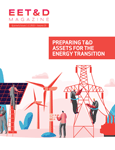How ‘bout that weather last year? The Pacific Northwest sweltered under a “heat dome” that melted power cables and shut down Portland’s streetcar service. Texans shivered through a deep freeze that took power from five million people and disrupted water service as well. Hurricane Ida shut down the grid for millions in Louisiana, Mississippi and throughout the Northeast.
It was a banner year for climate change, as the increasing frequency and impact of severe weather events left millions of people battered, and their communities and infrastructure systems stressed. According to a Washington Post examination of federal disaster declarations, more than one-third of all Americans live in a county that experienced a climate disaster during the summer of 2021.
Weather disruptions to the grid are nothing new — anything from a windblown tree branch to a raging wildfire can disrupt operation of overhead lines, causing power loss — but the recent barrage of events has highlighted the urgent need to make large-scale updates to the power grid.
Today, the problem is being felt more deeply because customers are increasingly sensitive to system failures – and service providers haven’t done the best job of managing expectations. But these events, though they deliver devastation and frustration, are also serving as catalysts for change.
Hardening against climate change
The rising impacts of climate change are driving utilities to reconsider and reprioritize how they approach system hardening. According to a 2021 Electric Report, which is a compilation of quantitative data and qualitative analysis based on a survey of industry participants, more than 80% of power utilities now say system hardening is more important than it was even a year ago. This may be due to the immediacy of 2021’s weather issues, but it could also reflect respondents’ awareness of the significant financial and reputational risk they face when systems fail.
This is reiterated by the CDP’s Global Supply Chain Report 2020, which estimates that by 2026, suppliers stand to lose a total of $1.26 trillion in revenue due to climate change, deforestation and water insecurity. The CDP, a nonprofit organization that runs a global disclosure system for managing environmental impacts, also projects that corporate buyers may face up to $120 billion in increased environmental costs by 2026.
So how can utilities get ahead of the climate change curve? There’s a long list of hardening techniques utilities can employ to protect their critical infrastructure.
For example, after the destruction of Superstorm Sandy in 2012, the State of New Jersey Board of Public Utilities laid out 103 activities to improve their preparedness and responses to major storms, including requiring utilities to “submit … an analysis of the current 100-year flood plan data for their respective areas of operation,” and “develop and submit … a Storm Damage and Outage Prediction Model.”
And the disruption is only expected to continue. The U.S. Department of Energy reports that between 2003 and 2012, an estimated 679 widespread power outages occurred in the U.S. due to severe weather, disrupting the lives of millions of Americans and costing the economy between $18 billion and $33 billion.
When asked which hardening techniques utilities are most likely to deploy within the next five years, respondents to the 2021 Electric Report survey pointed to continued vegetation management (57%), smart grid improvements (55%) and structural upgrades to transmission and distribution systems (48%) as the top three methods to help protect systems against extreme weather events.
Overgrown and unhealthy trees, branches and weeds are a threat to power lines, as they can dry out and create wildfires, long-term outages and devastating fatalities. Vegetation management allows utilities to control, clear and remove any possible hazards before an issue occurs.
For example, a fallen tree is to blame for the second-largest wildfire in California’s recorded history. In 2021, a tree fell onto one of Pacific Gas & Electric’s (PG&E) powerlines, sparking the Dixie Fire, which ended up burning nearly one million acres and destroying at least 1,329 structures, including more than 700 homes.
PG&E includes vegetation management as a core tenet in its 2022 Wildfire Mitigation Plan and plans to spend approximately $5.96 billion on wildfire mitigation this year, roughly $1 billion more than last year.
Smart grid improvements will also be prioritized. According to the Council of European Energy Regulators (CEER), smart grids can help meet climate change targets by helping to reduce power losses and lower energy consumption, thereby reducing GHG emissions and improving energy efficiency. Deploying smart systems that can provide awareness of the current state of infrastructure assets and automate quick restorative actions can be invaluable when it comes to protecting against climate change.
Structural upgrades to transmission and distribution poles and towers will be critical moving forward. Trillions of dollars have gone into building out the nearly 150 million utility poles in service in North America, according to the Washington Post, putting serious capital at risk during weather-related events.
Infrastructure is designed and built according to design criteria that relies on historic weather data, but the design basis is only as good as the information it is based upon. Today, ambient temperatures are changing, hurricane-force winds are becoming more prevalent, flood plains are shifting, and probabilities are increasing which can make design criteria obsolete. This is testing infrastructure, requiring utilities to reconsider new design standards and to invest in upgrades that will ensure their poles and towers can stand up against the climate risks associated with their regional location.
Utilities are also working to improve incident response time to severe weather events. The survey found that nearly one-third of respondents (32%) have either deployed or piloted projects — or are actively doing so — to help improve incident response time. Their efforts span from installing microgrids to smart meters, to “inundation protection for substations” and building new transmissions that can stand up to higher wind speeds.
The solution? Modeling and tracking
But all these efforts aside, utilities have one key tool in their pocket when it comes to making their systems more resilient. Nearly two-thirds (63%) of survey respondents are using risk analysis, modeling or similar inputs to prioritize resilience projects. The remaining 26% who don’t use these methods have most likely been stymied by cost or a lack of knowledge, while 11% said these approaches are not necessary to prioritize projects.
Data-driven modeling and risk analysis can help mitigate the risk of failure and unplanned outages by allowing for effective data collection and management, enabling utilities to monitor a broad range of operational metrics. Data collection and management systems include devices that can detect environmental, physical and electrical data such as flood sensors, cameras equipped with artificial intelligence (AI), drones equipped with high-resolution photography or live feeds that can identify damaged or at-risk equipment, temperature monitoring for both hot and cold weather threats and much more.
These assets are paired with technologies that improve outage management, reduce energy consumption, offer greater reliability and efficiency, and provide greater focus on the development of the smart grid. The use of remote monitoring paired with data analytics can help ensure continued operation.
Early anomaly detection can be used to detect issues before they become critical. For example, one Kansas-based global engineering, procurement and construction company worked on a project where, during a cold snap, the asset monitoring system detected a small change in lubricant oil temperature on a critical fan. This led to the discovery of a broken hinge on a skid enclosure that ended up freezing a water line. The system detected the issue early enough for the operator to thaw the frozen line and prevent downtime.
And data modeling and risk analysis rank as the No. 1 strategy for justifying expenses for climate change adaptation and resilience projects, according to 40% of respondents to the survey. Utilities can create data-driven models to simulate climate events and predict system responses to events — and then use this information as evidence when working to persuade regulators and investors of the case for hardening.
This is followed very closely by cost tracking to show cost recovery (39%). Respondents attach lesser weight to the review of case studies (9%), project demonstration (4%) and changes in insurability (3%).
Planning for the future
But no matter how many benefits are promised by data-driven modeling and risk analysis, there is a drawback when it comes to data collection and digitization — all too often, utilities end up with more information than they can manage. But asset management services integrated with data analytics capabilities exist to help utilities sort through the mounds of digital data, helping to prioritize the most important actions.
As asset monitoring becomes more available, utilities will find even deeper value in data modeling and risk analysis. These tools can help utilities guard against an increasingly temperamental climate, offering protection for valuable assets. Plus, utilities can leverage these tools to not only organize and prioritize extreme weather responses but also can deploy these capabilities to gather the necessary information for when it comes time to make a case for investment.
When it comes to preparing grids for extreme weather events, there is no one-size-fits-all approach. Success will require broad-based strategies and each utility will need a different strategy that accounts for system constraints, location, asset vulnerabilities, budgetary considerations, workforce availability and more. For example, electric utilities
in the Northeast may focus more on vegetation management than their counterparts in the desert Southwest, where high temperatures and drought force new demands.
Data modeling and risk analysis will be key going forward as they drive intelligence regarding the real-time “health” of infrastructure. The era of Big Data provides the opportunity to collect and analyze vast amounts of data, creating a 360-degree view of power infrastructure, letting us manage extreme events more effectively. The prediction and monitoring capabilities provided by digitization and data management will allow utilities to confidently define effective resiliency plans, guarding against a temperamental climate and the extreme weather events that can occur.

Arron Lewis is vice president, energy utilities, for Black & Veatch’s Energy & Process Industries business. Lewis previously served as managing director of the Global Power Distribution business for Black & Veatch. He has served with the company for more than 28 years. Lewis oversees the planning and execution of energy infrastructure projects that support the delivery of clean, reliable and resilient energy.







